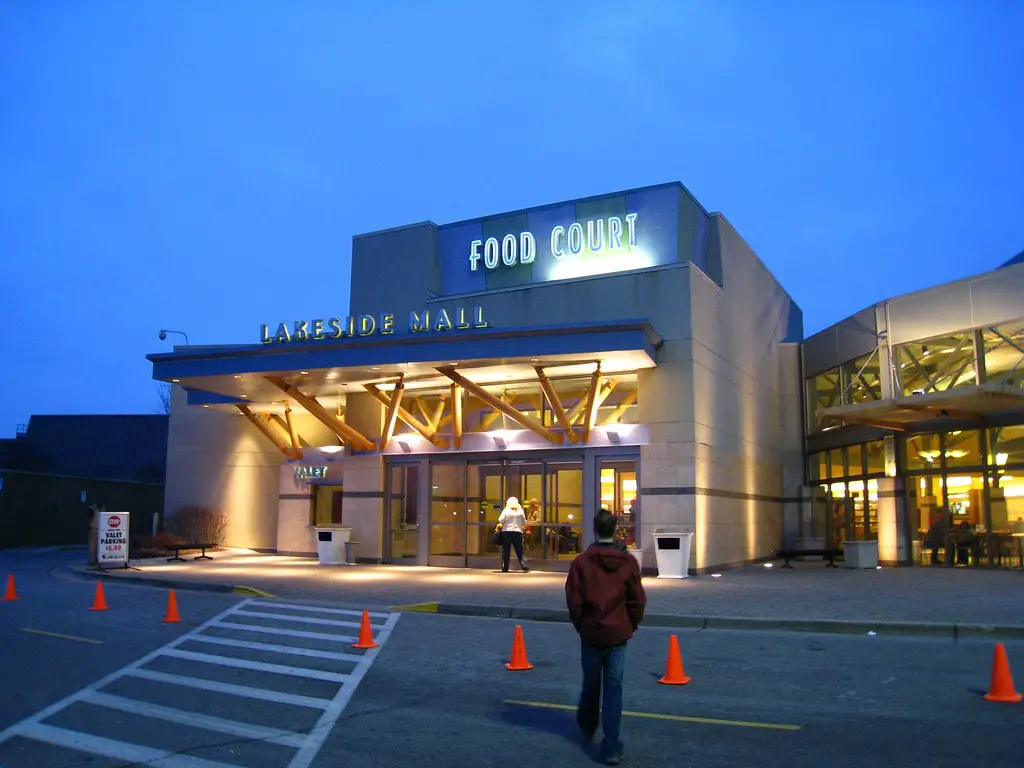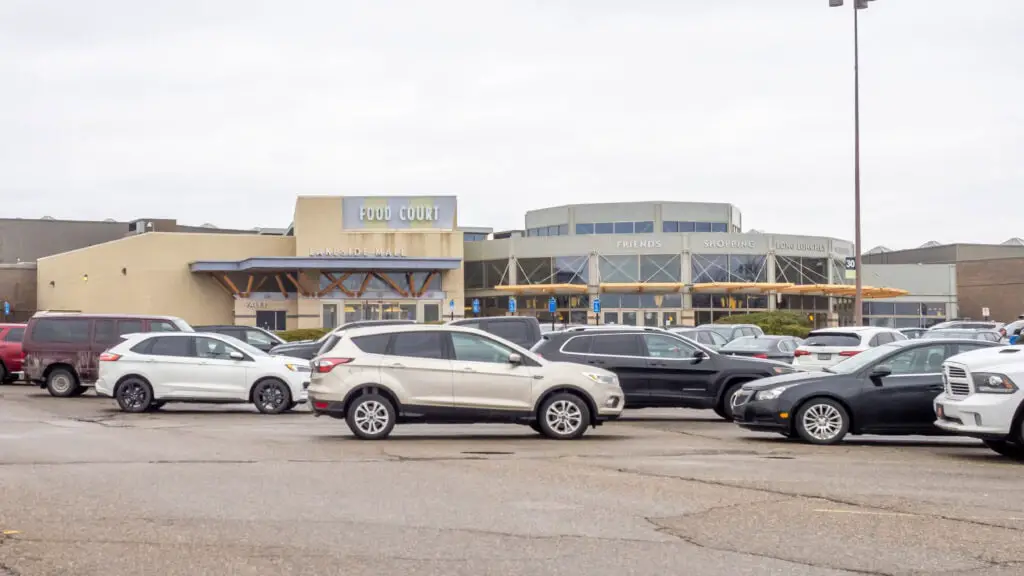Early Beginnings
Lakeside Mall was a joint venture between A. Alfred Taubman and Homart Development. It opened on March 2, 1976, in Sterling Heights, Michigan. At its inception, the mall featured four anchor stores: Sears, JCPenney, Hudson's, and Crowley's.
In 1978, Lord & Taylor joined as the fifth anchor store. The mall's design was similar to other Taubman-developed malls from that era, including Fairlane Town Center and Twelve Oaks Mall. The goal was to create a super-regional shopping center that could attract visitors from a wide area.
The mall's location on M-59 (Hall Road) between Hayes and Schoenherr Roads made it accessible to a large population. It quickly became a retail hub in the area, drawing numerous visitors who were looking for things to do near Detroit, MI.
The development of Lakeside Mall marked a significant commercial milestone for the region, setting the stage for future growth and expansion.
Growth and Expansion
Lakeside Mall grew rapidly after its opening. In 1983, Toys "R" Us opened a store across from the mall, adding to the attraction. This expansion helped the mall become a major destination for shopping and leisure.
In 1999, Hudson's bought the Crowley's building after Crowley's filed for bankruptcy. Hudson's moved its men's clothing and home goods into this space, creating a new shopping experience.
The mall's layout allowed for such changes without major disruptions, which was clever planning.
The 1980s brought an exciting feature to the mall: the Hydrotube. This indoor, tubular waterslide made Lakeside Mall unique in Michigan.
Families flocked to the mall to enjoy this fun addition, which covered large areas of the mall and became a landmark.
In 1988, Rodamco acquired Homart's interest and partnered with Taubman in a 50/50 joint venture. This change in ownership didn't slow the mall's growth.
Instead, it paved the way for future developments and enhancements. The mall kept evolving, keeping visitors interested.

Ownership Changes and Renovations
Ownership of Lakeside Mall changed hands several times, impacting its development. In 2000, Rodamco took full control after an interest swap with Taubman involving Twelve Oaks Mall.
Hudson's became Marshall Field's in 2001, following a name change by its parent company, Target Corp. This rebranding was part of a larger trend in retail.
Marshall Field's later turned into Macy's in 2006, when Federated Department Stores acquired May Company. These changes kept the mall's anchor stores fresh and relevant.
In the mid-2000s, new stores like Steve & Barry's and H&M opened, attracting different shoppers. H&M's first Michigan location opened at Lakeside Mall in June 2006.
This store brought European fashion trends to local shoppers, adding variety to the mall's offerings.
A $3 million renovation was announced in 2007. The project included new signage and better pedestrian access. Exterior renovations started in late 2008.
These updates aimed to modernize the mall and improve the shopping experience. The mall continued to adapt to changing retail trends and customer needs.
Decline of Anchor Stores
Lakeside Mall's fortunes shifted when its anchor stores began closing. Macy's tried to innovate by opening Macy's Backstage in 2017.
This concept aimed to attract bargain hunters with outlet-style offerings. However, this move couldn't reverse the overall trend of declining foot traffic and sales at the mall.
Sears announced in May 2018 that it would close its Lakeside location. By September 2, 2018, the store had shut its doors for good.
This closure was part of a larger downsizing plan by Sears, which affected many malls across the country.
Lord & Taylor followed soon after. In June 2019, they announced their closure. By September 15, 2019, the Lakeside Mall location had ceased operations. This loss marked another blow to the mall's status as a retail giant.
The loss of these major stores changed the shopping experience at Lakeside Mall. Fewer anchor stores meant fewer reasons for shoppers to visit, which impacted the smaller retailers as well.
The decline of these key stores signaled that the mall needed a new direction to survive.

Financial Struggles and Sales
Lakeside Mall has faced financial struggles since the late 2010s. Foot traffic and occupancy rates declined, putting pressure on its revenue. The mall's owners sought solutions to keep it viable, but the challenges were steep.
In December 2019, Out Of The Box Ventures, a division of Lionheart Capital, purchased the mall for $26.5 million.
This sale reflected the changing landscape of retail real estate. The new owners planned to revitalize the area and transform it into a mixed-use development.
The financial difficulties didn't end with the sale. To stay afloat, the mall needed to attract new tenants and visitors.
Out Of The Box Ventures announced plans to redevelop the surrounding properties. They aimed to create a more diverse and attractive environment for shoppers and residents.
Despite these efforts, the mall continued to struggle. The traditional retail model faced challenges from online shopping and changing consumer preferences.
The sale and planned redevelopment showed a recognition that the mall needed to evolve to remain relevant in the modern retail landscape.
Permanent Closure
Lakeside Mall finally faced closure after years of struggling. On May 1, 2024, the mall's owners announced it would close permanently on July 1, 2024. This news marked the end of an era for many who had fond memories of shopping there.
The final day was moved up to June 30, 2024, after a series of farewell events and sales aimed at clearing out the remaining inventory.
Conflicting reports about the exact date created some confusion, but the mall officially shut its doors by the end of June. The last days saw a rush of visitors wanting to experience the mall one last time.
The remaining anchor stores, Macy's and JCPenney decided to stay open during the transition.
Their decision provided some continuity as the rest of the mall prepared for redevelopment. Shoppers can still access these stores, but the main mall area will soon be gone.
Lakeside Mall Future Plans
Looking forward, the site of Lakeside Mall will transform. Out Of The Box Ventures plans to redevelop the area into Lakeside Town Center, a mixed-use development. Construction is expected to begin in 2025, bringing new life to the location.
The redevelopment will include retail, residential, and office spaces. This mixed-use approach aims to create a vibrant community hub. The design will focus on modern amenities and convenience, catering to current lifestyle trends.
Macy's and JCPenney will remain open during the redevelopment process. Their presence will help maintain some retail continuity while the rest of the mall changes. The new Lakeside Town Center will integrate these stores into its overall plan.
This transformation reflects a broader trend in real estate. Mixed-use developments offer flexibility and attract diverse groups of people.
Lakeside Town Center represents a fresh start, preserving the mall's legacy while adapting to new needs.
